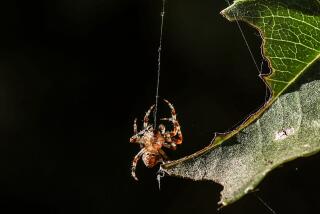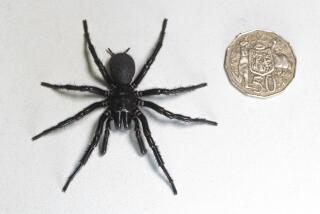Bugs in Computers Keep Real Insects Employed
- Share via
Ladies and gentlemen, Jim Lovisek could not be here today because his spiders couldn’t clear customs in time.
His eight-legged friends were supposed to be the special guest stars during the July television critics meeting in Pasadena as part of the preview of the fall adventure drama “Peter Benchley’s Amazon,” which premieres nationally next week, and turns up locally on KCOP-TV on Sept. 26. But Lovisek, director of the Toronto Nature Centre and supplier of wiggly creatures to the Eyemark Entertainment-syndicated series--could not obtain the necessary permits to ensure rapid arachnid transport. As a result, there was not a glimpse to be had of the promised 12-inch Goliath bird-eating spider from the jungles of South America.
“We could have just had Jim come, but then he’d just be a man with a beard,” said a show publicist.
Indeed, what is a man without his bugs? In the case of bug wranglers, not much. These entomology (bug) and herpetology (reptile) experts who corral creepy-crawlers for television and movies still supply one of the few real-life effects in an industry that is increasingly becoming digital.
“Computers are still not complex enough to match the movements of an insect realistically,” says Lovisek, 51. “Even if it fills a quarter of a frame, it will look phony. Creating one from scratch is also expensive and time-consuming. In TV, especially, everything is always a big rush. Usually, we only have a few weeks to complete each episode. The Web is the place to find and locate unusual specimens around the world, that before we didn’t have access to.”
Lovisek gets his Peruvian firestick insects from a breeder in England and his Goliath spiders from breeders in California and Florida. He supplied 10,000 cockroaches for the film “Mimic,” rounded up a hundred snakes in a pit for the syndicated “Relic Hunter,” and directed an army of carpenter ants for TV’s “The Adventures of Sinbad.”
“There were all kinds of angles and behaviors we had to master. You can’t train them, but you can utilize existing behavior,” says Lovisek, who controlled the ants’ movements by strategically blowing tiny amounts of dry ice on either side. “My job was to find the right kind of ant. I wanted an aggressive species, about three-quarters of an inch long with evil-looking mandibles. I finally found a contact in Malaysia.”
He also knows where to find four different species of roaches, depending on the behavioral demands of a shoot. “It gives you more options with shots, which is a help with tight deadlines,” Lovisek says.
“He’s a genius,” says Benchley. “He can get spiders to hit their marks every time.”
The overseas bug wrangling community has yet to incorporate the Internet as widely as the States. “Europe makes less use of the Internet, because it’s much more expensive,” says Mark O’Shea, reptile curator at West Midland Safari Park in Worcestershire, England, and, starting Sept. 30, the host of “O’Shea’s Big Adventure” on cable’s Animal Planet. He’s also wrangled in Sri Lanka and Papua New Guinea for the BBC and Discovery Channel.
“In America, you don’t have to pay for local calls to get online. And face it, the U.S. is technologically farther ahead than the rest of the world, so it’s second nature there,” he added. There are an estimated 3,000 to 4,000 Web sites devoted to caring for, locating and breeding rare creatures.
“If animals are on an endangered species list, there’s yards of red tape to bring them here,” says Armando Alarcon, a handler with Rancho Cucamonga-based Reptile Island, which supplies creatures for film and TV. “A lot of countries are closing the door for exportation of animals, because too many are being taken out of natural habitats. The trend now is to use captive-bred species. That way, we can find them here in the States, and we know they’re healthy and their temperament.”
That’s not to say Lovisek didn’t have his hands full locating a Usambara baboon spider from Tanzania to jump at the camera and a dead bird-eating spider to mount on an actor’s face. Even “Amazon’s” human actors no longer regard a bug as something to squash in a bathroom.
“It’s weird to think of these creatures as actors. I mean, the bug wrangler comes in with his load of bugs that are getting paid just as a much as I am,” says “Amazon” co-star Carol Alt with a laugh. Alt spent the earlier part of the week pulling maggots off a cast-mate. “I have a healthy respect for them. They are actors and an important part of our show, because they give it such reality.”
* “Peter Benchley’s Amazon” premieres at 7 p.m. Sept. 26 on KCOP-TV.
More to Read
The complete guide to home viewing
Get Screen Gab for everything about the TV shows and streaming movies everyone’s talking about.
You may occasionally receive promotional content from the Los Angeles Times.






